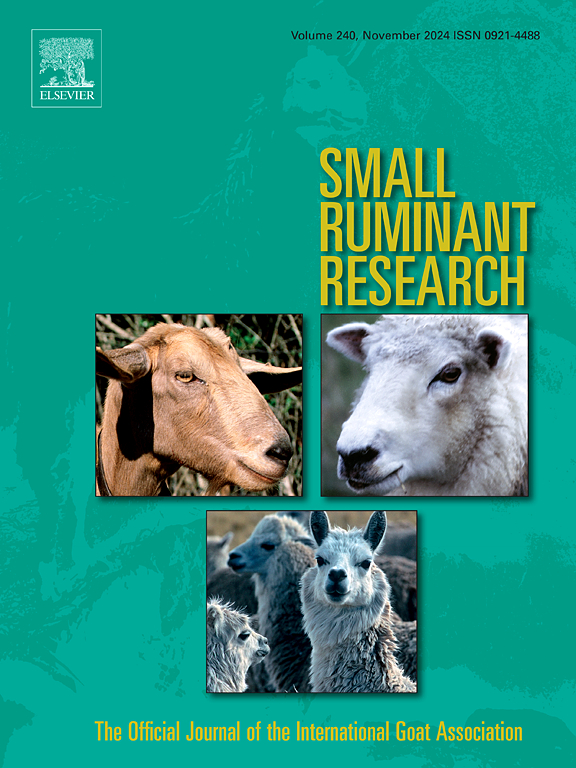Novel mutations in exon 2 of follistatin (FST) gene associated with wool fiber diameter in sheep
IF 1.6
3区 农林科学
Q2 AGRICULTURE, DAIRY & ANIMAL SCIENCE
引用次数: 0
Abstract
Follistatin (FST) is proved to be a key player in hair follicle morphogenesis. This study was designed to investigate the association of SNPs in the FST gene with wool quality traits i.e. fibre diameter, crimp number, and staple length in sheep breeds from Pakistan. Genomic DNA isolated from representative samples of the sheep breeds. A 4444 bp fragment of the FST gene (covering exons 2–6 and the intervening introns) was amplified through PCR. The amplified products were sequenced through Next Generation Sequencing (NGS) technology. The results showed variations in the wool quality parameters among the sheep breeds. Lowest crimp number was recorded for Hashtnagri and Mazai sheep breeds (1.7 ± 0.24 and 1.0 ± 0.12 crimps/cm, respectively). While Kari sheep had the thinnest fibre diameter (27.9 ± 1.19 μm) compared to other sheep breeds. Longest staple length (10.36 ± 0.73 cm) was observed for Ghalji sheep. Sequencing results revealed a total of 51 variants in the targeted region of the FST gene. Kari sheep’s FST gene was the most diverse possessing nine unique variants in the intronic region and two in the coding region. A total of 11 FST variants showed association with fiber diameter, among which two novel missense SNPs (c.229 A>G and c.236 T > C) in the exon 2 were unique to Kari sheep. These SNPs were found to have effect the protein structure and stability and may be used as markers for fine wool having thinner fiber diameter in sheep. These results suggest significant impact of variation in the FST gene on wool fibre diameter.
绵羊卵泡抑素(FST)基因外显子2与羊毛纤维直径相关的新突变
卵泡抑素(Follistatin, FST)在毛囊形态发生中起着关键作用。本研究旨在研究巴基斯坦绵羊品种中FST基因snp与羊毛品质性状(即纤维直径、卷曲数和短绒长度)的关系。从绵羊品种的代表性样本中分离的基因组DNA。通过PCR扩增FST基因4444 bp片段(覆盖2-6外显子及其介子)。扩增产物通过下一代测序(NGS)技术进行测序。结果表明,不同绵羊品种间羊毛品质参数存在差异。Hashtnagri羊和Mazai羊的卷曲数最低(分别为1.7 ± 0.24和1.0 ± 0.12)。而卡里羊的纤维直径(27.9 ± 1.19 μm)是其他绵羊品种中最细的。加尔吉羊短纤长度最长,为10.36 ± 0.73 cm。测序结果显示,FST基因的靶区共有51个变异。Kari羊的FST基因是最多样化的,在内含子区有9个独特的变体,在编码区有2个。共有11个FST变异与纤维直径相关,其中2个新的错义snp (C .229 A>;G和C .236 T >; C)是Kari羊所特有的。这些snp对羊毛蛋白的结构和稳定性有一定的影响,可作为羊毛细毛细细的标记。这些结果表明,FST基因的变异对羊毛纤维直径有显著影响。
本文章由计算机程序翻译,如有差异,请以英文原文为准。
求助全文
约1分钟内获得全文
求助全文
来源期刊

Small Ruminant Research
农林科学-奶制品与动物科学
CiteScore
3.10
自引率
11.10%
发文量
210
审稿时长
12.5 weeks
期刊介绍:
Small Ruminant Research publishes original, basic and applied research articles, technical notes, and review articles on research relating to goats, sheep, deer, the New World camelids llama, alpaca, vicuna and guanaco, and the Old World camels.
Topics covered include nutrition, physiology, anatomy, genetics, microbiology, ethology, product technology, socio-economics, management, sustainability and environment, veterinary medicine and husbandry engineering.
 求助内容:
求助内容: 应助结果提醒方式:
应助结果提醒方式:


